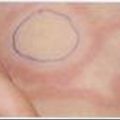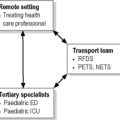6.2 Inhaled foreign body
Treatment
Total obstruction
Untreated, total airway obstruction will rapidly lead to hypoxia, loss of consciousness and subsequently cardiorespiratory arrest. In the child presenting with complete obstruction, basic life support should be commenced (see Chapter 2.4 on Resuscitation). The performance of back blows and chest thrusts to dislodge the foreign body should be followed by attempted ventilation with bag and mask. If these methods are unable to remove the foreign body and allow ventilation, then direct visualisation of the larynx and Magill forceps extraction of the foreign body should occur if possible. In the unlikely event of a foreign body visualised below the cords, suctioning may expedite its removal or, if not possible, advancing the object past the carina with an endotracheal tube or bougie may allow life-saving ventilation as a temporising measure.
Lower airway foreign body
Treatment
Initially, the patient’s airway and breathing should be assessed and oxygen given if required. Referral for bronchoscopy is the definitive treatment for confirmed or suspicious cases. Indications for bronchoscopy should be based on history, examination and radiological investigations ‘2 of 3 rule’ (Table 6.2.1).
Digoy G.P. Diagnosis and management of upper aerodigestive tract foreign bodies. Otolaryngol Clin N Am. 2008;41:485-496.
Heyer C.M., Bollmeier M.E., Rossler L., et al. Evaluation of clinical, radiologic, and laboratory prebronchoscopy findings in children with suspected foreign body aspiration. J Ped Surg. 2006;41:1882-1888.
Midulla F., Guidi R., Barbato A., et al. Foreign body aspiration in children. Pediatr Int. 2005;47:663-668.
Malick M.S., Khan A.R., Al-Bassam A. Late presentation of tracheobronchial foreign body aspiration in children. J Trop Pediatr. 2005;51(3):145-147.




